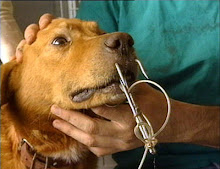Wednesday, March 17, 2010
EPA Scrutinizes Pesticides In Flea & Tick Products
After a yearlong intensified evaluation of spot on pesticide products for flea and tick control the Environmental Protection Agency has reported reactions to the use of these products that range from skin irritation to seizures and sometimes even death.
Read the article by Elissa Rivas here.
The EPA is reminding consumers to always carefully read and follow all instructions on the label for these products.
Here are some tips that the EPA has to offer:
Safety tips for pet owners:
• Consult your veterinarian about the best way to to protect your pets from fleas and ticks and whether pesticides are even needed.
• Use extra care before use on weak, aged, medicated, sick, pregnant, or nursing pets, or on pets that have previously shown signs of sensitivity to pesticide products.
• If you use a spot-on product or any other pesticide on your pet, carefully read and follow the product label.
• Use flea and tick control products only on the animal specified by the product label - for example, dog products for dogs only and cat products for cats only.
• Follow any label prohibitions against use on weak, aged, medicated, sick, pregnant, or nursing pets, or on pets that have previously shown sensitivity to pesticide products. Apply only the amount indicated for the size of the animal being treated.
• Do not apply to kittens or puppies unless the product label specifically allows this treatment. Pay attention to the age restrictions for puppies and kittens on the label.
• Monitor your pet for side effects or signs of sensitivity after applying the product, particularly when using the product on your pet for the first time. Do not apply spot-ons to pets known to be sensitive to pesticide products.
• If your pet experiences an adverse reaction, immediately bathe the pet with mild soap and rinse with large amounts of water.
• Keep the package with the product container (such as individual applicator tubes). Also keep the package after treatment in case adverse effects occur. You will want to have the instructions at hand, as well as contact information for the manufacturer.
Flea Control Tips
The following tips may help to prevent, reduce, or eliminate flea infestations:
• Vacuuming on a daily basis to remove eggs, larvae and adults is the best method for initial control of a flea infestation. It is important to vacuum the following areas: carpets, cushioned furniture, cracks and crevices on floors, along baseboards and the basement.
• Steam cleaning carpets may also help as the hot steam and soap can kill fleas in all stages of the life cycle. Pay particular attention to areas where pets sleep.
• Wash all pet bedding and family bedding on which pets lie in hot, soapy water every two to three weeks. If an infestation is severe, discard old pet bedding and replace it with fresh, clean material.
• Flea combs are very effective tools in the suppression of adult fleas. They allow hair to pass through the tines but not the fleas, removing fleas as well as flea feces and dried blood. Focus combing on those parts of the pet where the most fleas congregate, usually the neck or tail area. When fleas are caught, deposit them in hot soapy water to kill them.
• Consider keeping pets indoors.
Besides spot-ons, there are other pesticides registered for flea and tick control on pets. These include shampoos, collars, dust, and sprays. Consumers should apply the same precautions when using these products as recommended for spot-ons. Pet owners may also wish to consult their veterinarian for advice and recommendations.
Subscribe to:
Post Comments (Atom)




No comments:
Post a Comment